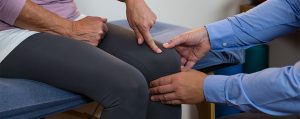5 Tips to Prevent Common Running Injuries
Posted on by Paige Gibbens, PT, DPT
Running has become an increasingly popular activity for exercise among people of all ages. In fact, 60 million people within the United States participate in some form of running activity each year. People participate in running activities for numerous reasons including: improving fitness, weight concerns, running a race/competition, staying healthy, and having fun. Running for 5 – 10 minutes per day has shown to decrease the risk of death and cardiovascular disease. Running less than 50 minutes per week has also shown to reduce the risk of death from heart disease when compared to individuals who don’t participate in running at all. While running has many benefits, about 50% of people get injured each year from running. Running injuries can be caused by poor running technique, reduced strength and flexibility, improper footwear, as well as overuse.
(more…)
The Orthopedic Growing Pains of Parenting
Posted on by Erik Krol, MOT, OTR/L
Have you ever paid attention to the amount of times you lift or handle your newborn child or toddler throughout the day? As a parent of two growing children under the age of two, I could not help but notice (and feel the effects of) the physical demands of my kids. The bulky-but-useful changing stations, running strollers, ergo-carriers, standing towers, and bassinets all require lifting and/or carrying the child while assisting them into some (not always desired but necessary) positions. You do what you must as parents, but how exactly are you getting the job done and at what orthopedic cost? Here is a list of some common overuse injuries as well as a few tips that may prevent them with just a few seconds of extra thought and planning!
(more…)
No Big Toe, No Big Deal?
Posted on by Heather Strickland, B.S., PTA
Walking, running, jogging, dancing, are all functional activities we do daily without thinking about it. They simply come second nature to us and are essential to a healthy life. What if your big toe, also known as the hallux, was amputated? Would you still be able to do what you love at all or even with ease?
(more…)
How Can Physical Therapy Help Your Headache?
Posted on by George Zakharia, DPT
Physical therapists are special health practitioners, but did you know they can treat people from head to toe? That certainly includes treating those dreaded headaches. Read on to learn more about headaches and the power physical therapy has in treating them.
(more…)
Will Cracking Your Knuckles Cause Arthritis?
Posted on by Shelia M. Tenny, OTR/L, CHT
Knuckle cracking or popping is a habit that many people develop, despite being told it could cause arthritis or harm, but is that really accurate? Long story short, no it does not cause damage in a healthy person. Many start cracking their knuckles as a nervous habit, tick, restlessness, or they’ve noticed the looser feeling in their joints.
(more…)
Strength Training Considerations for Youth Athletes
Posted on by Tara Hackney, PT, DPT, OCS, KTTP
As young kids’ participation in sports increases, strength training in youth athletes also continues to be seen more frequently. Strength is an important part of daily life as well as for participation in sports. Strength training at a young age can be beneficial for coordination, flexibility, and bone density as well as general health. We know that preventative exercise (prehabilitation) focuses on strengthening muscle groups that are overused in specific sports (i.e. rotator cuff for overhead throwing athletes) and it may reduce overuse injuries in these athletes. Increasing incidence of strength training may lead to questions about safety and how much training children should be doing for their age and level.
(more…)
How to Fall Correctly to Prevent Hand Injuries
Posted on by Lizzy Miotti PT, DPT
As a physical therapist and hand therapist, one of the biggest concerns I hear from my patients is that they are worried they are going to fall and hurt themselves. It is not uncommon for a therapist to be treating injuries that resulted from a fall. The upper extremity (shoulder through the fingers) is a common place for injuries to occur following a fall as many will use their hands to brace their fall in order to protect their face or head. This type of fall is called a F.O.O.S.H or a fall on an outstretched hand. This blog will briefly look into common injuries of the upper extremity with a fall and will talk about ways to prevent these injuries.
(more…)
3 Conditions You Didn’t Know Dry Needling Can Help
Posted on by Athletico
As is true with many things in life, there may be more contributing to your pain than meets the eye. In fact, the point of pain may not be the source. Muscles throughout the body can create myofascial trigger points, often referred to as “knots.” These palpable tender spots are a group of muscle fibers that maintain a semi-contracted state for too long. The fascia, which is a non- contractile tissue, covers nearly every muscle fiber, can also be a part of this point restriction. These restrictions can be very tender to touch and can have a greater influence on how the entire muscle activates. Through years of research, medical professionals have been able to map common referral patterns for each muscle.1
(more…)

